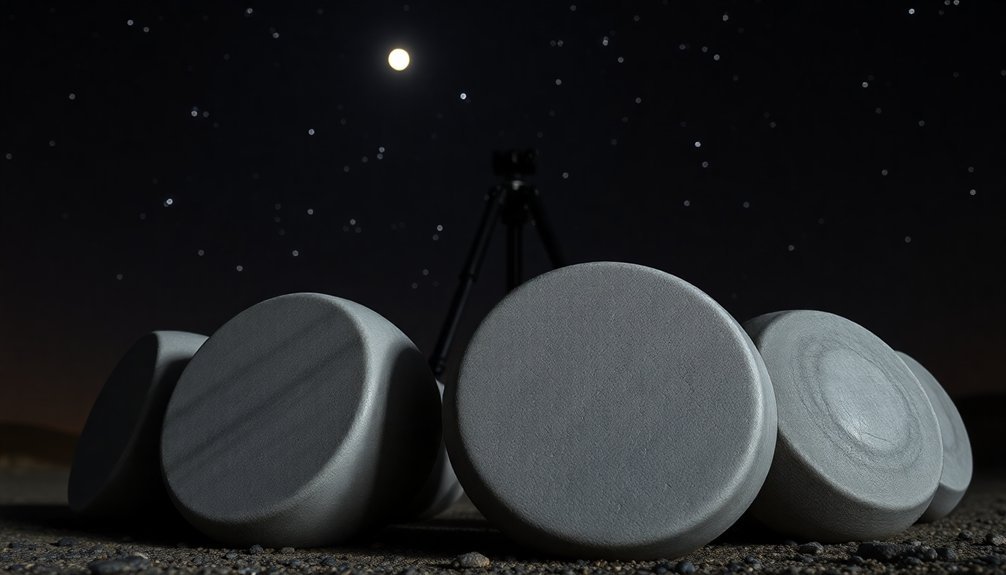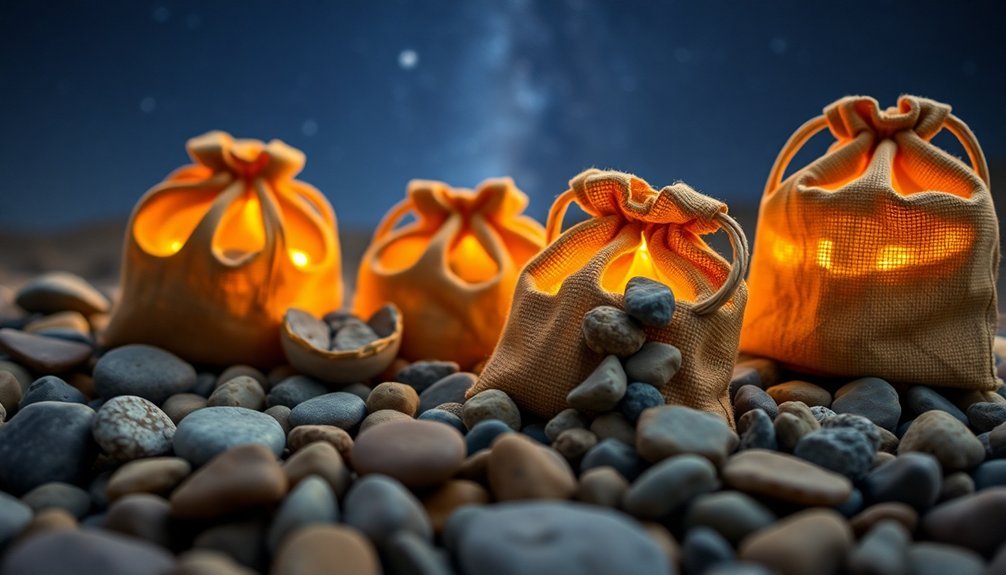The best tripod hook weights for steady stargazing include water-filled bottles for budget-conscious astronomers, customizable sand bags, professional kettlebells, DIY concrete weights, hook-and-chain systems, rock bags for field use, and ground-based platforms for heavy telescopes. You'll eliminate frustrating vibrations that blur your celestial views with these simple solutions. Each option offers unique advantages based on your specific needs, equipment, and viewing conditions. Discover which stabilization method will transform your astronomical observations from shaky to spectacular.
Water-Filled Bottles: The Ultimate Budget Weight Solution

While serious astronomers often invest in expensive equipment to enhance their stargazing, water-filled bottles provide a remarkably effective solution for tripod stabilization at virtually no cost.
You'll find this method particularly useful in windy conditions when telescope shake can ruin your celestial observations.
Almost any bottle works—plastic water bottles, durable Nalgenes, or even larger juice containers depending on how much weight you need.
Simply fill them with water, hang them from your tripod's center hook, and you'll immediately notice increased stability. The convenient clip-in design makes attaching bottles quick and effortless for any astronomy enthusiast.
You can easily adjust the weight by changing the water level or using multiple bottles.
Unlike sand or rocks, water won't create a mess, and you can empty the bottles for lightweight transport between stargazing locations.
Sand-Filled Bags: Customizable Stability for Any Tripod
You'll appreciate sand-filled bags for their adjustable weight distribution, allowing you to add precisely the amount of ballast your stargazing setup requires.
Setting up these customizable weights couldn't be simpler—just hang them from your tripod hook or drape them across the legs for instant stability. Pre-filled versions weighing 15 lbs each offer immediate use without the hassle of finding filling material.
At a fraction of the cost of specialized astronomy weights, these versatile bags provide professional-grade stability without breaking your equipment budget.
Adjustable Weight Distribution
For serious stargazers seeking ideal image quality, adjustable weight distribution represents one of the most versatile stability solutions available. You'll find this approach particularly effective in combating vibrations that compromise your celestial observations. By strategically adding weights to your tripod, you're fundamentally anchoring your setup against environmental factors like wind or uneven terrain. Unlike dedicated counterweights used with tracking mounts, these tripod hook weights work excellently with both alt-azimuth and equatorial systems.
| Weight Type | Portability | Best For |
|---|---|---|
| Sand Bags | High | Traveling observers |
| Metal Weights | Medium | Permanent setups |
| Camera Bags | High | Improvised solutions |
| Hybrid Solutions | Medium | Versatile conditions |
The beauty of adjustable weights lies in their adaptability across different tripod designs. Whether you're using a basic pan-and-tilt or advanced equatorial mount, you'll achieve enhanced stability without investing in expensive specialized equipment. This cost-effective approach delivers professional-quality results for both casual stargazing and serious astrophotography.
Easy Setup Process
Sand-filled bags offer perhaps the most versatile weight solution for stargazing enthusiasts because they combine exceptional stability with straightforward deployment.
You'll appreciate how easily these weights can be customized based on your specific needs—simply add or remove sand to achieve your desired weight.
Setting up is remarkably simple: hang the sandbag from your tripod's hook or place it directly on the ground beneath your setup.
If your tripod doesn't include a built-in hook, you can easily install an S hook through the center column.
The extra weight from sandbags enhances tripod stability for capturing sharp images of celestial objects.
For particularly windy nights or uneven terrain, you can increase stability by placing the sandbag on the ground and securing your tripod to it with rope.
This creates a solid anchor that prevents unwanted movement while you're capturing the night sky.
Cost-Effective Stability Option
When it comes to tripod stability, sand-filled bags represent one of the most cost-effective solutions available to stargazers on a budget.
These versatile weights can be customized with different fillers—sand, buckshot, or water—giving you flexibility based on your needs.
Made from durable Cordura Nylon, these bags offer exceptional longevity while minimizing replacement costs.
You'll find options ranging from 5 to 35 pounds, perfect for matching your specific setup requirements.
The economic advantage comes from their reusability—simply empty them for transport and refill when needed.
Their saddle design drapes easily over tripod legs, providing immediate stability on uneven terrain.
For astrophotographers concerned with vibration reduction during long exposures, these weights deliver professional-level stability without the premium price tag of specialized equipment. The double-zipper design provides added security, ensuring your filling material stays contained during those critical night photography sessions.
Kettlebells: Professional-Grade Weights for Serious Astronomers
Serious astronomers seeking professional-grade stability solutions often turn to kettlebells as their tripod weight of choice. Made from durable cast iron or steel, these weights offer precise calibration and standardized options that eliminate guesswork from your setup.
You'll appreciate how kettlebells lower your equipment's center of gravity, greatly reducing vibrations and wind disturbances. Unlike makeshift solutions, they won't slosh or shift during critical observations. The convenient handle design makes them easy to hang from your tripod hook, instantly improving tracking accuracy and image quality. A 10lb counterweight has proven effective with various astronomy mounts, providing sufficient stability without stressing the tripod components.
While they represent a higher initial investment than rocks or DIY weights, kettlebells provide long-term value with their lifetime warranties and versatility. Their portability makes them ideal for traveling astronomers who need consistent, reliable stability across different observation sites.
DIY Concrete Weights: Long-lasting and Cost-effective Options

For stargazers on a budget, DIY concrete weights offer an exceptional combination of durability and affordability that commercial alternatives simply can't match.
You'll appreciate how these homemade solutions provide customized stability for your telescope setup while saving significant money in the long run.
Creating your own concrete weights is surprisingly straightforward, requiring only basic materials from any home improvement store. When planning your project, remember that using old paving slabs can provide a solid foundation for your weights.
The finished products will withstand years of outdoor use without maintenance or corrosion concerns.
- Create any size or shape to perfectly fit your specific equipment
- Adjust the weight by varying dimensions or adding steel rebar for density
- Enjoy decades of use with concrete's superior weather resistance
- Customize appearance with paint or textures to match your gear
- Stabilize your equipment against wind and vibrations for clearer viewing
Hook-and-Chain Systems: Distributing Weight for Maximum Stability
Hook-and-chain systems represent the most versatile approach to tripod stabilization, allowing you to distribute weight evenly around your setup's center of gravity. These systems work by creating downward tension that considerably reduces vibrations, making your stargazing experience more precise. Products like the Leofoto HK-01 Tripod Weight Hook offer excellent compatibility with LS Ranger Series Tripods while featuring a hinged design that prevents obstruction when folded.
| Weight Type | Pros | Cons |
|---|---|---|
| Battery Packs | Dual function (power + weight) | Limited weight capacity |
| Scuba Weights | Compact, substantial heft | May require special holders |
| Barbell Plates | Standardized sizes, stackable | Potentially bulky to transport |
| Sand Bags | Adjustable weight, collapsible | Can leak, moisture sensitive |
| Water Bottles | Readily available anywhere | Less weight per volume |
Remember that weight distribution isn't linear—you'll reach a point where adding more weight won't improve stability. Focus on even distribution and keep weights within your tripod's rated capacity for safety.
Rock Bags: Utilizing Natural Materials for On-the-Go Stargazers

Rock bags offer an ingenious empty-fill system that lets you travel light and use nearby natural materials for tripod stabilization.
These weatherproof pouches protect collected rocks, sand, or gravel from moisture while maintaining the weight needed for steady observations.
The versatile design allows quick filling when you reach your destination and easy emptying before heading home, making them perfect companions for mobile astronomers who don't want to carry extra weight during hikes to remote viewing locations.
Quality rock bags should include dew drainage holes to prevent water accumulation that could compromise stability and add unwanted weight.
Lightweight Collection Solutions
The savvy stargazer knows that stabilizing a tripod doesn't require commercial weights when nature provides plenty of options. Rock bags made from durable materials like Dyneema offer a perfect solution for collecting and storing stones to anchor your equipment while keeping your campsite organized.
These versatile bags integrate seamlessly with your other gear and come in various sizes to accommodate different weight needs:
- Made from sustainable natural materials that reduce environmental impact
- Lightweight design adds minimal bulk to your stargazing pack
- Multi-functional use for food storage when not stabilizing equipment
- Quick setup and takedown improves efficiency during nighttime observations
- Compatible with bear line systems for safe overnight storage
You'll appreciate how these simple tools enhance both the stability of your observations and your overall outdoor experience. When stargazing from your truck, these rock bags provide additional utility as they help you access remote stargazing locations without carrying excessive equipment.
Weatherproof Rock Storage
Weather-resistant rock bags serve as the unsung heroes of the amateur astronomer's toolkit, protecting your natural weights from the elements while keeping them readily accessible during extended stargazing sessions. These portable containers secure your tripod while adding minimal bulk to your stargazing gear. The design philosophy mirrors Joshua Tree's stargazing suite which emphasizes passive design principles tailored to the unique characteristics of nighttime observation.
When selecting materials for your rock bag, consider both durability and environmental conditions you'll encounter during your celestial observations.
| Material | Weather Resistance | Durability |
|---|---|---|
| Canvas with PVC | Excellent | High |
| Treated Leather | Good | Very High |
| Recycled Nylon | Excellent | Medium |
| Wool Blend | Moderate | Medium |
| Cotton with Silicone | Good | Medium |
Look for bags with secure closures and reflective elements for nighttime visibility. The best options feature breathable components that prevent moisture buildup while maintaining waterproof integrity—essential when stargazing in dewy conditions.
Versatile Empty-Fill System
While protecting your rocks serves an important purpose, savvy stargazers also benefit from empty-fill systems that offer unparalleled flexibility during astronomical adventures.
These rock bags allow you to utilize natural materials like sand, stones, or pebbles found at your observation site, eliminating the need to transport heavy weights.
Made from durable, weather-resistant fabrics with secure closures, these bags can be filled to your desired weight based on conditions and equipment needs. Much like how astronomers study cosmic voids to understand the universe's structure, these adaptable systems help observers optimize their viewing experience by addressing environmental challenges.
You'll appreciate the improved stability on uneven terrain and enhanced wind resistance for clearer imaging.
- Lowers your telescope's center of gravity for better stability
- Reduces vibrations for sharper long-exposure photography
- Adapts to varying weights needed for different environments
- Packs flat when empty for effortless transport
- Provides a cost-effective, environmentally neutral solution
Weight Platforms: Ground-Based Solutions for Heavy Telescopes

When stability matters most for serious stargazing sessions, ground-based weight platforms become essential equipment for astronomers using heavy telescopes. These robust systems can support instruments weighing up to 50kg while providing superior vibration control through even weight distribution. Some advanced platforms feature dual-axis systems that enable both RA and DEC movement for precise object tracking.
| Platform Type | Material | Best For |
|---|---|---|
| Equatorial | Aluminum/Steel | Tracking celestial objects (up to 45 min) |
| Standard | Plywood/Composite | General stability on varied terrain |
| Portable | Carbon Fiber | Travel astronomy with lighter scopes |
You'll appreciate platforms with adjustable height features that prevent neck strain during extended viewing sessions. Most quality platforms incorporate weatherproof materials like stainless steel fasteners and aluminum structures, ensuring they'll withstand outdoor conditions. For maximum effectiveness, look for models with integrated stackable weight systems that let you customize stability based on your telescope's size.
Frequently Asked Questions
Can Tripod Weights Damage My Tripod Over Time?
Yes, tripod weights can damage your tripod if they exceed the recommended load capacity. You'll risk structural damage over time, but properly sized weights used within your tripod's limits won't cause harm.
How Much Total Weight Should I Use for Strong Winds?
For strong winds, you'll want to add 10-20 pounds of weight to your tripod, ensuring it doesn't exceed your tripod's capacity. Consider using ground-based weights with sand bags or scuba weights for maximum stability.
Are There Weight Solutions for Travel by Plane?
You'll find flying with weights challenging. Consider collapsible sandbags, buyable locally, or using luggage/backpacks as makeshift weights. TSA restricts liquids, but solid weights can go in checked baggage with potential fees.
Do I Need Different Weights for Different Telescope Sizes?
Yes, you'll need different weights for different telescope sizes. Small scopes need minimal weight, medium ones require balanced weights, and large telescopes demand heavier counterweights to maintain stability during your observations.
Can I Use Weights on Tabletop or Mini Tripods?
You can use weights on tabletop or mini tripods, but proceed with caution. They have lower weight capacities, so use lighter weights and guarantee they're properly balanced to avoid tipping or damaging your compact setup.
In Summary
You've now explored seven excellent tripod stabilization options, from water bottles to weight platforms. Whether you're an amateur stargazer or experienced astronomer, there's a solution that fits your budget and needs. Don't let wind or uneven terrain ruin your celestial observations. With the right weight system, you'll enjoy steadier views and sharper images as you scan the night sky. Choose what works best for your setup and enjoy the stars!





Leave a Reply